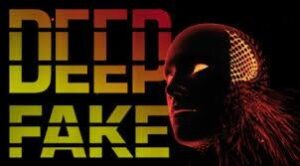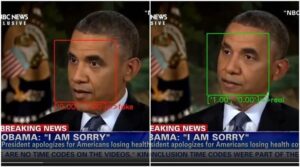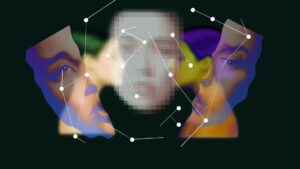CHALLENGES AND THE BENEFITS OF DEEP-FAKES FOR LAW–ENFORCEMENT

Deep-Fakes, also known as Deepfake technology, are used in the Netherlands to help solve crimes. However, their use has some limitations. This technology may be an excellent way to catch criminals, but it can also become a massive security threat.
WHAT ARE DEEP FAKES?
Deepfakes, or synthetic media, are a relatively new technology in the cybercriminal arsenal. A Deepfake is an artificially created video or audio clip that the creators generate by applying artificial intelligence or machine learning to a video or audio clip. DeepFakes can be used to create a variety of malicious and
benign outcomes. For example, Deep-Fakes created to feign legitimate celebrity endorsements for a
commercial product and to blackmail individuals or businesses.

The first recorded application of Deep fakes was in creating fake pornographic images. The first public cases of counterfeit media got documented in recent months. The creation of these fake media has been made possible by the rapid progress in artificial intelligence. Machine learning can analyse large amounts of data to generate authentic-looking fake photos and videos. In a recent cyber incident, a criminal defrauded an energy company of $243,000 by impersonating the voice of the chief executive. He also used an app that generated fake nude images of women.
THE DANGERS OF DEEP-FAKES
Deep-Fakes have the potential to create serious harm. They are a form of artificial intelligence that can generate realistic-looking fake photos and videos. Cybercriminals also use these to do things such as blackmailing people, phishing, and hijacking IoT devices. However, the dangers of Deep-Fakes are far from limited to just cyber criminals.
There are several threats from Deep-Fakes. About 96% of Deep-Fakes are pornographic videos that reduce women to sexual objects and cause emotional distress. Deepfake could depict a person as indulging in antisocial behaviors and could create social discord, increase polarization, and can even influence the election outcome. Deep-Fakes could accelerate the trust deficit in traditional media. non-state actors could use them to create chaos in the target country, undermining trust in institutions. Non-state actors (terrorist organizations) could misuse them to stir anti-state sentiments. Liars could
dismiss an unpleasant truth as deep fake or fake news, giving more credibility to denials. the weaponization of deep fakes to dismiss objective truths in the media as fake news is already happening.

Some experts believe deep fakes could be a significant problem for financial institutions. Many financial experts have rated them as the top technology challenge. The threat is more pronounced in countries with unstable economic conditions, as well as those with weaker financial oversight mechanisms. Deep-Fakes can play into existing economic fears, and even amplify them. Nevertheless, it’s not easy to gauge the impact of DeepFakes, as there have been only a handful of documented cases to date.
One of the most prominent uses of Deep-Fakes is as a form of political propaganda. For example, the
MIT Center for Advanced Virtuality used a deepfake to share a fake moon landing disaster speech. While
this is the first time there has been public recognition of artificial intelligence-generated media as such,
there’s been plenty of controversy over its effectiveness.
DEEP-FAKES ARE A LOOMING CHALLENGE FOR SECURITY
Deep Fakes are a looming threat to national security. They can manipulate elections, spread
disinformation and incite terrorism. A single convincing video can throw an election, crash the stock
market and lead to riots. In addition, deep fakes can be created and distributed with readily-available
software. There is a need for comprehensive solutions that address Deep-Fakes which requires a
holistic approach, including technological detection, education, and law enforcement. These solutions
should be multi-stakeholder and collaborative.

First, education is a crucial part of the solution. The public needs basic information on how Deep-Fakes get made and how to identify them. As more people get exposed to deep fakes, there will be more erosion of trust in the media. Next, countries need a legal framework for regulating Deep-Fakes based on research and careful analysis of the processes involved. It should also be a part of a well-thought-out overall strategy. Third, there is a need to prepare the legal system for a deep fake technology that can
pose opposition from civil rights groups. While the government can’t stop the development and commercialization of deep fakes, it can help to establish a fair and consistent legal process.
THE PROBLEM OF DEEP-FAKES
Deepfakes, or artificial intelligence-generated media, are becoming a growing threat. They have been used to spread disinformation and political discord, particularly in emerging markets. It is essential to know what to expect, how to respond and how to use this technology in your favour. A deep fake is a digital file manipulated to mimic a natural person’s face, created with publicly available photos. Sometimes, they are used to impersonate corporate executives and apply for remote work.

In a recent study, two out of three respondents said they had encountered a deep fake. Using these techniques is easier than ever, and criminals are incorporating them into their schemes. As technology progresses, the quality and accuracy of Deep-Fakes will only improve. For instance, artificial intelligence can now produce fake images that look authentic. One of the biggest threats is privacy. Deep-Fakes can be used to create fraudulent documents or manipulate the media. Some law enforcement agencies have
issued warnings about these types of digital attacks.
DEEP FAKES CAN BE USED TO SOLVE CRIMES
The Dutch police have made a groundbreaking discovery that could revolutionize the way we solve crimes.Solving crimes using deep-fakes is an exciting development in the world of crime-fighting. Dutch police have recently begun using deep-fakes to help them solve serious crimes, like murder and kidnapping. Using this technology, they can create an image of a missing person, or get a better look at a suspect or witness. By creating a realistic image of the suspect or witness, they can get a better idea of what they look like and who they may be. This is especially helpful when there are no witnesses or when the witnesses can’t clearly see the suspect. It can also be used to help find missing persons, as the deep-fakes can provide an accurate representation of what the person looks like now. Also, “deep-fakes” can also be used to recreate witnesses for murder scenes. This technique uses existing video footage to create a realistic, computer-generated version of someone who wasn’t there during the crime. This deep-fake witness can then be used to recreate the events as they happened, providing the police with vital information about the crimeDeep-fakes are a powerful tool for law enforcement and can be used to solve
crimes more quickly and efficiently, making them a valuable asset for police forces everywhere.

Further, by combining the latest in artificial intelligence and facial recognition technology, police will be able to transform audio recordings of witnesses and victims into realistic images. This technology is being used to help identify and catch suspects in a variety of cases, ranging from murder to theft. With deep-fakes, police can now create a photo-realistic image of a suspect that they can then use to compare with a database of images. This has been a game changer for law enforcement and is helping them solve cases in ways that were never possible before. With this technique, the police are now able to solve crimes faster and more accurately than ever before. It’s an exciting development that could change the way police departments around the world investigate and solve crimes!
HOW DUTCH POLICE ARE USING DEEP-FAKES TO SOLVE CRIMES
The Dutch police are using Deep-Fakes to solve crimes. It’s a technology that uses artificial intelligence to create a video that mimics the movements of a real person. We can use this technology for good or bad. But there is a growing concern about the use of these videos. Police say it’s an excellent way to get clues from the public. Since the video’s release on YouTube, they’ve received a dozen tips. They are now working to verify the authenticity of these tips. Using deep fakes is one way to attract more witnesses to a case. However, authorities are finding it difficult to detect these fake videos. Often, these videos have unnerving movements and can be deceptive. Ultimately, the viis an appeal to the public to come forward with information about a murder. Dutch police have been trying to solve a cold case for years, but they could not find the killer. Authorities believe a criminal gang operated near the metro station where the shooting occurred. The police, to lure witnesses into providing information, decided to recreate a video of the boy’s murder in 2003. According to the spokesperson, the video is the first of its kind. During the video creation, police worked with the family of Sedar Soares.

THE CHALLENGE OF DEEP-FAKES
Deep-Fakes are synthetic media that can be produced with artificial intelligence and distributed by computer networks. Miscreants can use fake media for disinformation and terrorism and support criminal activities. Synthetic media has gained attention as a national security concern as miscreants could use it with devastating effects in countries with unstable economic environments. The financial sector has been a target for DeepFakes.

In recent months, several publicly known cases of Deep-Fakes have got identified. These include a mother of a child who manipulated an audio recording of her husband to convince a court of his violent behaviour. Another case involved an energy company that was defrauded for $243,000 by criminals who impersonated the voice of the chief executive. The legal and regulatory landscape for Deep-Fakes is complex. Legislators, law enforcement, and the legal system must work together to find an effective solution. Some protection groups may challenge rulings regulating deep fakes, especially if the rulings are too narrow, which could result in the inability to combat deep fakes. Law enforcement must develop new technologies and skills to prevent and counter these attacks. Police are devising programs in various countries to detect and analyse deep fakes. Programs include DARPA’s Media Forensics, which supports an automated assessment of the integrity of videos. Similarly, Facebook and McAfee are developing
software to develop deep fakes.
DEEP-FAKE COULD BECOME A STAPLE FOR ORGANISED CRIME
Deep-Fakes are a new kind of media derived from artificial intelligence designed to look like genuine photos or videos. Lawbreakers use them for many purposes, including document fraud and political disinformation. Deep-Fakes are becoming increasingly sophisticated. Artificial intelligence advancements can produce more realistic and convincing fake videos and photographs, which can lead to severe consequences. For instance, a deepfake could produce a misleading video of a bank executive describing a liquidity crisis. If enough people share this deepfake, it could trigger a successful bank run, likely during financial turmoil. Aside from the threat to the market, deeper fakes also potentially undermine public safety and trust in institutions. As more and more people begin to distrust traditional media and news sources, these astroturfing tactics can accelerate the erosion of public confidence.

Deep-Fakes could be used to spread misinformation, create fake recordings of enforcement actions and generate non-consensual pornography. Some experts predict these methods could become a major staple of organized crime over the coming years.

IMPACT OF DEEP-FAKES ON LAW-ENFORCEMENT
Deep-Fakes are a form of subversive digital activity. They artificially generate media or process data to influence concrete decisions. Depending on the content, Deep-Fakes could threaten the rule of law, democracy and the well-being of citizens. Technology is still in its infancy. However, its adverse effects are already manifesting themselves. One of the first things law enforcement needs to address is how to detect and respond to deep fakes. In particular, law enforcement agencies must improve their skills and
collaboration with computer science experts. As technology advances, Deep-Fakes will become more common. Miscreants are already using Deep-Fakes in crimes such as document fraud, non-consensual pornography and identity theft. They also pose challenges to trials and evidence management. For example, in a recent case, an energy company was defrauded by a group of criminals who faked the voice of its chief executive. Deep fakes, therefore could mean financial harm, spook customers and cause
money transfers. Deep-Fakes also threaten social institutions and relationships if used to influence elections and international decision-making. It’s unlikely that individual law enforcement agencies will have the resources to investigate Deep-Fakes properly unless steps are taken to develop tools to detect deep fakes and regulate them by enacting laws.

HOW COUNTRIES ARE COMBATING DEEP-FAKES?
To combat deep fakes, China has announced a policy which requires service providers and users to ensure that any doctored content using the technology is explicitly labeled and traced back to its source. The EU has an updated code of practice that requires tech companies, including Google, Meta, and Twitter, to take measures to counter Deep-Fakes on their platforms. If found non-compliant, these companies could face fines of as much as 6% of their annual global turnover. The USA has enacted a Deep Fake Task Force Act to assist the Department of Homeland Security (DHS) in countering Deepfake technology by conducting an annual study of deep fakes. In India, there are no legal rules against using deep fake technology. However, specific laws exist for copyright violation, Defamation and cyber crimes that could address the concerns of deep fakes. Canada is undertaking some of the most cutting-edge AI research with several domestic and foreign actors.

SOLUTIONS TO CURB DEEP-FAKES
The most effective tool is media literacy for consumers to combat disinformation and deep fakes. Countries should put in place meaningful regulations by involving technology, industry, policymakers and other stakeholders to disincentive creation and distribution of deep fakes. Nations should research and develop technologies that will quickly detect deep fakes and enact laws to punish miscreants who mislead people using deep fakes. People must become intelligent internet intelligent consumers and not
share and contribute to the infodemic by discerning and refusing to share fake content.
 Dr K. Jayanth Murali is a retired IPS officer and a Life Coach. He is the author of four books, including the best-selling 42 Mondays. He is passionate about painting, farming, and long-distance running . He has run several marathons and has two entries in the Asian book of Records in full and half marathon categories. He lives with his family in Chennai, India. When he is not running, he is either writing or chilling with a book.
Dr K. Jayanth Murali is a retired IPS officer and a Life Coach. He is the author of four books, including the best-selling 42 Mondays. He is passionate about painting, farming, and long-distance running . He has run several marathons and has two entries in the Asian book of Records in full and half marathon categories. He lives with his family in Chennai, India. When he is not running, he is either writing or chilling with a book.
